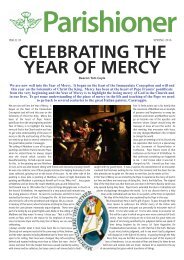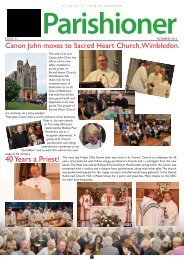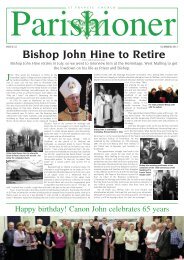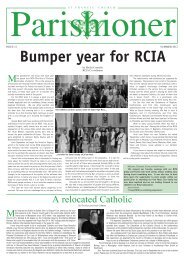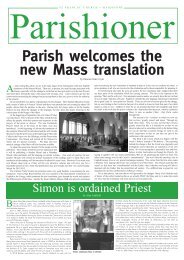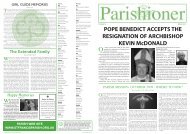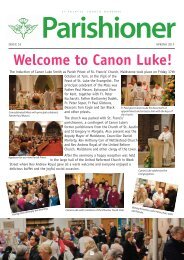The Parishioner - Edition 25
The Parishioner is the quarterly publication of St. Francis' Catholic Parish, Maidstone.
The Parishioner is the quarterly publication of St. Francis' Catholic Parish, Maidstone.
- No tags were found...
You also want an ePaper? Increase the reach of your titles
YUMPU automatically turns print PDFs into web optimized ePapers that Google loves.
St Anna SchafferWritten and illustrated by Charlotte CassidySt.Anna Schaffer was born on the 18th of February1882 to impoverished, pious Catholic parents inMindelstetten, lower Bavaria, Germany. As aschoolgirl Anna had a deep devotion to Jesus andthe Blessed Virgin Mary and she had hopes ofentering a religious order and becoming amissionary nun. Her father, however, a joiner, diedsuddenly at the age of forty, leaving his widow anchildren in dire poverty. So, at the age of fourteen,Anna had to leave school to work to support hermother and younger siblings. She worked first asa maid for a local counciller, then in a laundry. Shealso wanted to save a dowry, which she needed tobecome a nun (in those days women had to makea financial contribution to enter a convent).Two years later, in 1898, when Anna wassixteen, she heard Jesus’s voice within her soul tellher that before she reached the age of twenty she was destined to endurea long and painful suffering, and to pray the Rosary. At first Anna wasalarmed by this divine prophesy, then she told Jesus she would willinglyaccept anything He wanted of her and she began to pry the Rosary eachday.On that fateful evening of February 4th 1901, while working in thelaundry, the stovepipe over the laundry boiler became detached from thewall. When Anna climbed some steps and tried to reattach the stovepipe,she slipped and fell into a large vat of boiling bleach, which severelyscalded her legs above the knees.She was taken in a cart to hospital and over the next few monthsthirty operations followed. When repeated skin grafts failed and herdreadfully scarred legs became partially paralysed, her physician, Dr.Waldin, regretfully told her there was nothing more they could do for herpainful burns and she was sent home.Anna was nineteen. She would now be bedridden for the rest of herlife and she would suffer much, just as Jesus told her. She had to abandonall hopes of ever becoming a nun. Her burns had to be carefully dresseddaily, which caused her much pain. Her mother became her full time carer.Because Anna could no longer work, the Schaffer family would endureextreme poverty.Although Anna struggled for a while to accept that she had becomean invalid and clung to the hope that her damaged legs would eventuallyheal, she never lost her love for her Catholic faith. She became a memberof the Third Franciscan Order and even though she endured constantsuffering from her burns, her great love for the Sacred Heart of Jesus andthe Blessed Virgin Mary deepened.Parish Priest Fr. Karl Rieger would bring her the Eucharist each day.Anna wrote joyfully of this, “I cannot write by pen how happy I am everytime after Holy Communion. Ah, I forget my earthly suffering and thelonging of my poor soul draws me every moment to adore my God andSaviour hidden in the Blessed Sacrament.” On rare occasions Anna wasbrought to church in an armchair to attend Mass.In 1902, Anna’s legs became completely paralysed. Fr. Rieger wouldlater say that he never once heard Anna complain of her painful sufferings.Anna’s profound holiness soon became known in the small Bavarian townand townspeople would often visit her requesting her prayer. She wouldcomfort them with cheering words when they told her their problems andshe would write many encouraging letters to those seeking her advice.She became loved by the townspeople, even non-believers were drawn toher patience, kindness and the joy she radiated despite her suffering.Children especially loved to visit her, she would tell them of Jesus, theBlessed Virgin Mary and the saints. She wouldalso knit beautiful garments for friends andintricately embroider cloths for the local chapels.Anna was unable to sleep at night andduring this time she would pray and set beforeGod all the petitions the townspeople entrustedto her. She would also pray for priests and theChurch. In 1910 she offered her suffering hersuffering in reparation for sinners to the SacredHeart of Jesus. Some weeks later she had a visionof St. Francis, then Christ, who accepted hersacrifice of reparation and she received thestigma ata on her hands and feet. She kept thishidden from the townspeople that visited her asshe did not want fame or sensationalism, and shewould pray fervently to remove these wounds ofChrist’s Passion.She often said she had three keys to Heaven, her suffering, her sewingneedle and her pen, adding “With these three different keys, I strive eachday to open the door to Heaven. Each of them must be decorated withthree little crosses which are prayer, sacrifice and selflessness.”From 1910 to 19<strong>25</strong>, Anna wrote her spiritual thoughts in twelvenotebooks. She considered that her sufferings had value and she wouldalways unite her sufferings to Christ on the Cross. In one of her notebooksshe wrote of her gratitude to Jesus. “I thank you for my Cross and mysufferings, in union with the thanksgiving of Mary, the Mother of Sorrows.”Anna’s spiritual writings have become an inspiration for many faithfultoday, In 19<strong>25</strong>, Anna was diagnosed with a terminal illness. She had tostop her sewing work and her letter writing, both of which she loved, andit was now impossible for her to be brought to church in an armchair toattend Mass. Realising she had only weeks to live, she wrote in hernotebook, “Soon I will live from God Who is Life itself. Heaven has no priceand I rejoice every minute in the Lord’s call to the infinitely beautifulhomeland.”On October 5th 19<strong>25</strong>, her condition worsened. After receiving HolyCommunion from Fr. Rieger, Anna made the sign of the Cross andwhispering these last words, “Lord Jesus, I love You, Anna Schaffer diedpeacefully. She was forty three.Her funeral procession was the largest ever recorded in the Bavariantown of Mindelstetten. <strong>The</strong> many townspeople who had known Anna allsaid they felt they had been in the presence of a saint. Immediately hertomb within the Catholic parish church in Mindelstetten became a placeof pilgrimage and the many graces and cures hundreds of pilgrims receivedhave been attributed to her intercession.She was beatified in 1999 by St Pope John Paul II and canonized onOctober 21st 2012 by Pope Benedict XVI. In his canonization homily, theHoly Father said, “St Anna Schaffer’s sick-bed became her cloister cell andher suffering a missionary service. She understood her situation as a lovingcall from the Crucified One to follow Him. Strengthened by dailyCommunion, she became an untiring intercessor in prayer and a mirror ofGod’s love for the many who sought her counsel.” St Anna Schaffer’s lovefor her faith and her acceptance of suffering continues to inspire manypeople faced with physical suffering today.Months before his own death in 2005, St Pope John Paul II, whenspeaking of St Anna Schaffer, said these poignant words. “She was givento grow in the correct understanding that weakness and suffering are thepages on which God writes His Gospel. Her sick-bed became a cradle ofan apostolate that extended to the whole world”.14





